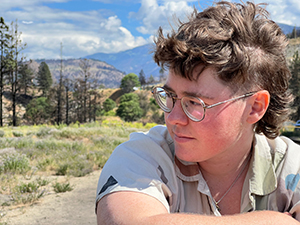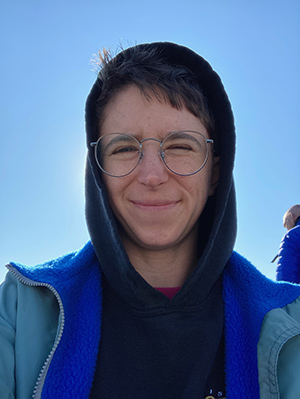Fragments into Truths: Kara Stanton interviews Aldyn Chwelos

Volunteer Kara Stanton talks with Aldyn Chwelos, winner of our 2024 Open Season CNF Award with "The Pathfinder," featured in our spring issue #226. They discuss symbolic containers, second person storytelling, and rewriting and reshaping our conceptions of ourselves.
Aldyn Chwelos is a writer, journalist and former full-stack developer living on Lekwungen territory in Victoria, BC. Their work in all these domains centres on community, story, and change.
Chwelos has been published in Reader's Digest Canada, Canadian Geographic, and Hakai Magazine. They are also Managing Editor of the Climate Disaster Project, where they share stories and solutions from disaster-affected individuals and communities.
This is such a sharp and poignant piece, which finds a way to fit so compactly within the bounds of this (ill-fated) car, the Pathfinder. How did the vehicle emerge as a symbolic container in your writing of this piece? Was it obvious to you from the beginning, or did you have to make your way to it?
I’d wanted to write a version of this essay for a long time but a three-year relationship creates a lot of memories, a lot of different thoughts and feelings to parse. Each time I tried to sift through them, it felt like too much to contain. I had mostly given up on it. But the idea resurfaced during an assigned writing exercise for a university course. In that exercise, I made use of the car crash as a metaphor for the relationship which allowed me, in 250 words, to write a mini memoir out of something I’d convinced myself would take 25,000. As I expanded the narrative from there, I discovered the Pathfinder had more symbolic resonance than just the car crash. And with so many scenes from that relationship taking place in or around vehicles, it also provided a lens through which to focus three years of memories. Discovering the vehicle as a symbolic container is what finally made writing the essay possible.
What made you lean towards the second person in the telling of this story; why did “you” feel like the right fit?
With this essay I wanted to explore those past selves that are both us and not us. To hold that earlier version of myself with empathy and understanding but also separate from the me that I am now. The second person helped create that distance, and I felt allowed a distinction between the narrator reflecting the experience and the “you” experiencing it.
I imagine there was also a bit of relief for me in the distance created. Words shape our understanding of our worlds. And that holds as true for the writer of those words as for the reader. Using “I” would have felt like putting on a coat that hasn’t fit in a very long time. It would have been uncomfortable, and I wouldn’t have wanted to look in the mirror.
This piece holds abundant quiet reflections on heteronormative gender roles, and the shapes we contort our bodies into to mold to each other. One moment that particularly struck me was in the camping scene, as the narrator is doing yoga and watching a pair of swans—“There are no other birds. Who are they performing for?” It’s clear that the narrator is highly conscious of the role they are expected to play in their own relationship. How did you navigate representing this highly gendered dynamic while pointing towards the ways in which it alternately comforts and chafes against the narrator?
That’s a beautiful question.
I did worry in describing both these aspects that I’d be caught in a binary. As though the alternating, as you describe, between comfort and chafe were like two sides of a coin I was flipping and inevitably we’d land at either heads or tails. Neither of which would be true. The reality is much more molten and much harder to quantify.
My approach was just to embrace honesty and contradiction as best I could. Whenever I struck something uncomfortable, where my instinct was to shy away or be embarrassed, I tried to lean in. The first draft of each scene began more or less as a recount of that memory in situ. As I edited, I layered in reflections that were more removed, and came from years after the particular moments.
The swans were a late addition. And I think they reflect not only the narrator’s self-consciousness in that moment but also my own self-consciousness at presenting that scene to an audience. The interesting thing is that once you’ve become attuned to those roles and dynamics, and the ways you’ve both willingly and unwillingly, knowingly and unknowingly, been shaped by them, then resistance itself can feel like a role you’re required to play. So to embrace both the comforts and chafes felt like embracing a failure of convention at multiple levels.
As a journalist as well as a nonfiction writer, I’m wondering how it felt for you to open up in this in some ways deeply intimate piece. Does this kind of storytelling come naturally to you, or did it require an emotional leap?
I was a writer first before I became a journalist and I started out writing short stories that were really autofiction—though I’m not sure I fully realized that at the time. So in some ways, I had always been doing this. Nonfiction just required that I be honest about what I was doing.
That being said, I experienced a sort of hangover after writing this essay.
Joan Didion has described writing as a hostile act. “It’s hostile to try to wrench around someone else’s mind that way,” she told the journalist Linda Khuel in an interview. “Nobody wants to hear about someone else’s dream, good or bad; nobody wants to walk around with it. The writer is always tricking the reader into listening to the dream.” Didion went on to say she never imagines a reader other than herself: “So very possibly I’m committing an aggressive and hostile act toward myself.”
There’s an uneasiness when you’re shaping yourself for an audience. You create a version of yourself to serve a purpose, and to serve a time and place. It’s not a complete portrait, it never could be. But there’s something about narrativizing that turns fragments into truths. And it’s unsettling to think I’m rewriting my own understanding of myself to serve the craft. Even if we are constantly rewriting and reshaping our conceptions of ourselves.
What are you reading these days—any nonfiction in particular? What’s lighting you up?
I always have multiple books on the go. Currently, I’m reading The Abundance, a collection of Annie Dillard essays. Her work never fails to awe. I find she’s a writer who demands to be read with a pen in hand: so I can take notes and because afterwards, I feel propelled into the grind of my own writing.
I’ve nearly finished John Vaillant’s Fire Weather, which is as excellent and terrifying as one would expect. Because my journalistic work is focused on disaster-affected communities, that’s been a focus of my reading lately. And I’m always curious how the fiction writers approach those topics so I’m partway through two post-apocalyptic novels: Brown Girl in The Ring by Nalo Hopkinson and Harrow by Joy Williams.

Kara Stanton









